North America is home to multiple black and blue butterflies. These colorful butterflies are seen in all sizes and all types of color combinations.
Some are only black and blue while others also show orange, white, green, tan, and brown colors.
Additional coloring on black and blue butterflies is specific to dots, marks, and stripes.
Many blue butterflies have dark visible veins across the wings.
These species of butterflies live in all parts of the US. Many are found in the Southern parts, especially those also native to Central and South America.
However, black and blue butterflies are also common in Northern states such as Ohio and even live in Alaska. The following species are considered the most common.
Table of Contents
1. Red-spotted Admiral
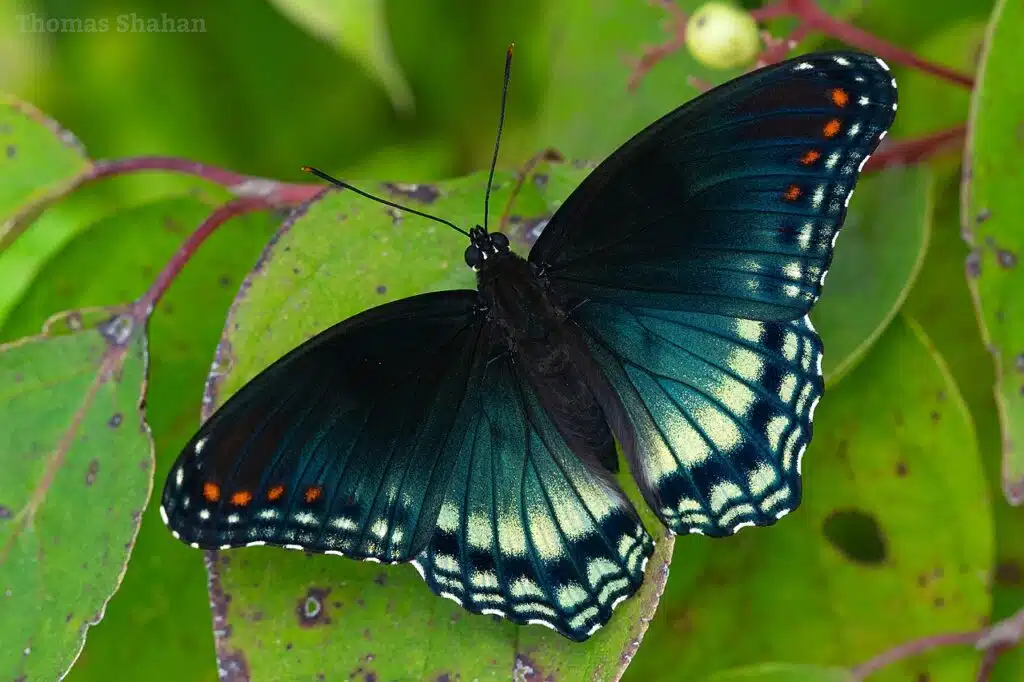
The Red-spotted Admiral (Limenitis arthemis) is a common black and blue butterfly in North America. The species has black wings with blue margins and red spots.
The wingspan of the species can reach a maximum of 2-3 inches.
Butterflies of this genus are common in forests across the Eastern United States.
Birch and other evergreen forests are among their favorite habitats.
This butterfly can be seen in many other environments at higher altitudes.
Red-spotted Admirals are versatile when it comes to feeding. They feed on sap but they also eat carrion and even dung.
Red-spotted Admirals don’t primarily feed on plant nectar. They might only consider plant nectar as an alternative to planting sap.
2. Pipevine Swallowtail
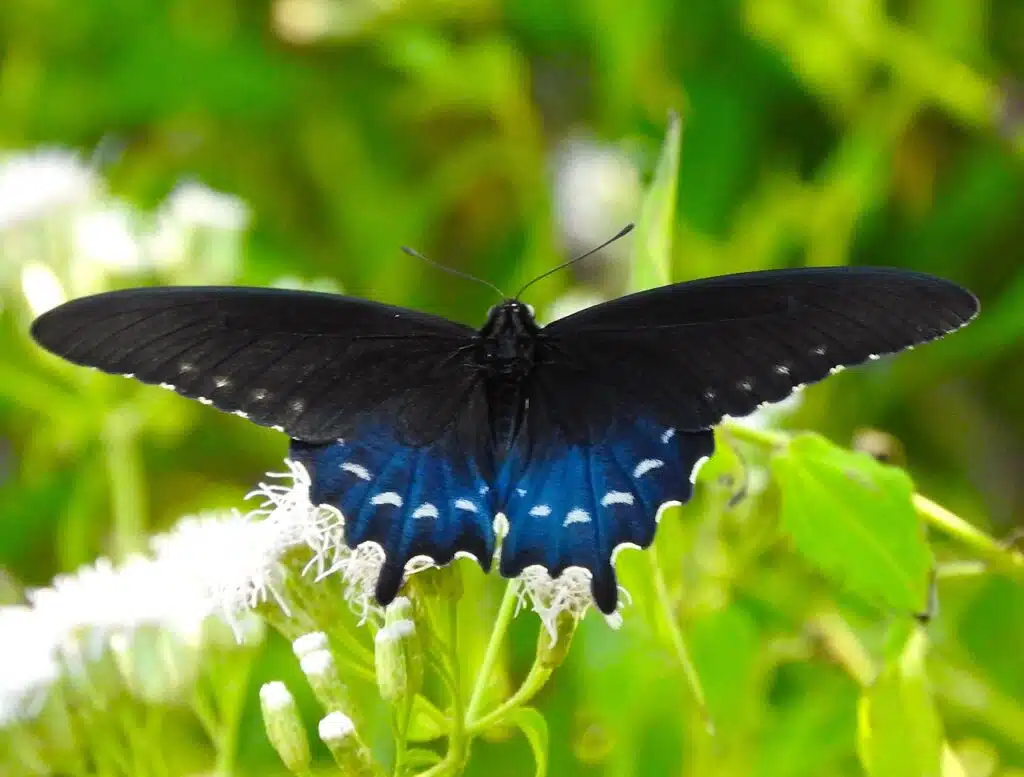
Pipevine Swallowtails (Battus philenor) are mostly black butterflies with vivid blue coloring on the hindwings.
They also have light blue marginal spots.
Color differences are seen between males and females as the female has more iridescent blue coloring.
Pipevine Swallowtails are known to feed on the nectar of a few flower species. They’re a common sight on a thistle.
These butterflies also sink on pink flowers rich in nectar.
Pipevine Swallowtail caterpillars have a lower pupation rate due to their habits of establishing themselves on potentially toxic plants.
Caterpillars of the species are often seen on toxic Aristolochia plants which eventually kill them.
3. Summer Azure
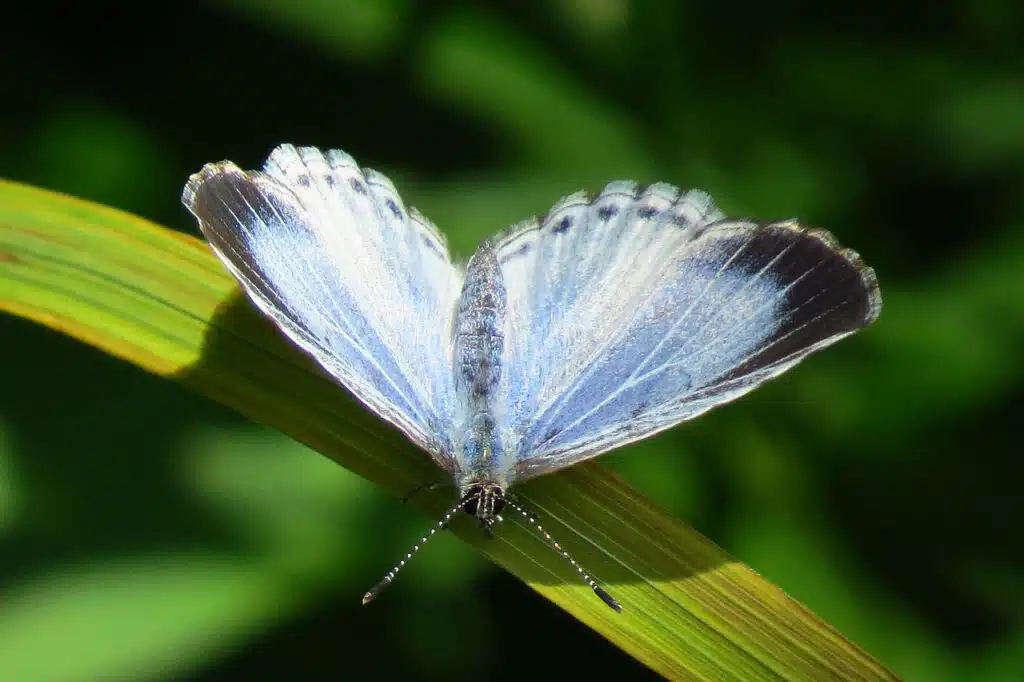
Summer Azures (Celastrina neglecta) have a long flight season in Eastern and Central US. The species remains active until October.
Summer Azures have a light blue color with black margins. The light blue nuance of the wings can appear closer to white in females.
This species feeds on the nectar of various flower while its larvae feed on various types of dogwood.
Summer Azures are some of the common small blue butterflies as they have a wingspan slightly longer than 1 inch.
The caterpillar of the species doesn’t resemble the black and blue adults. It has a light green uniform color.
4. Atala
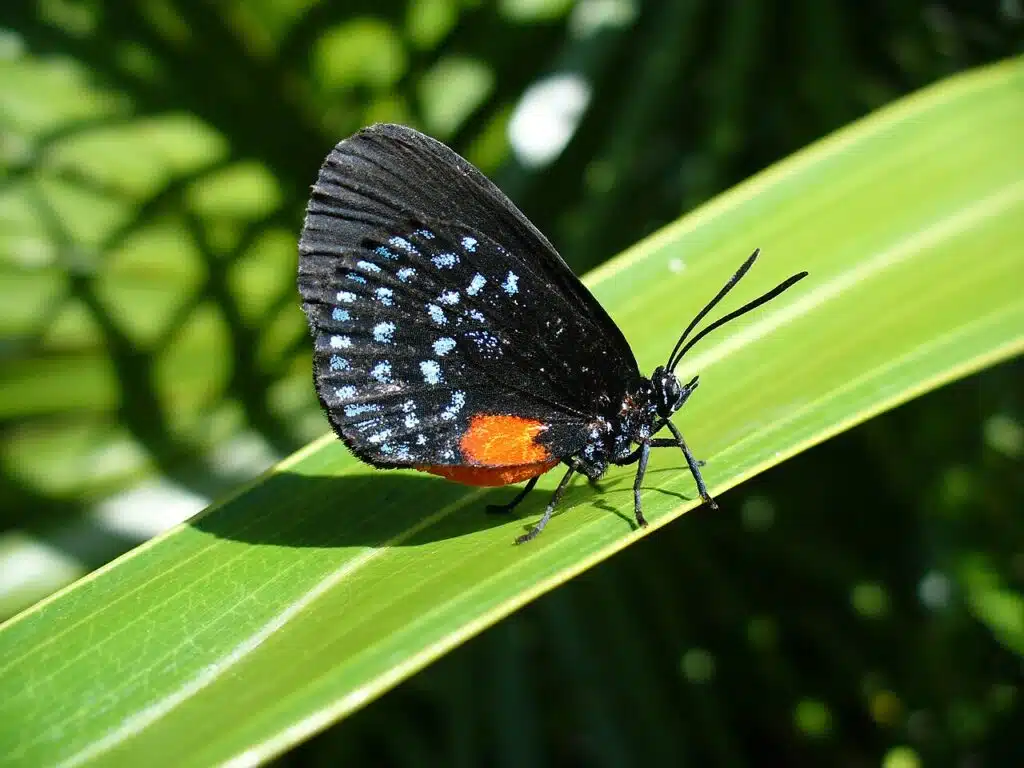
Atala (Eumaeus atala) is a common black and blue species in Florida’s subtropical climate.
This butterfly has black wings with blue spots and a red abdomen.
Its wingspan measures at least 1.5 inches and can sometimes reach 2 inches.
This species feeds on many subtropical flowers for their nectar. This includes feeding on the nectar of wild coffee.
Atala’s very specific habitat requirements mean this species has very specific needs in terms of food.
Its status is endangered even if it has been reported in small numbers in neighboring states.
5. Mangrove Skipper
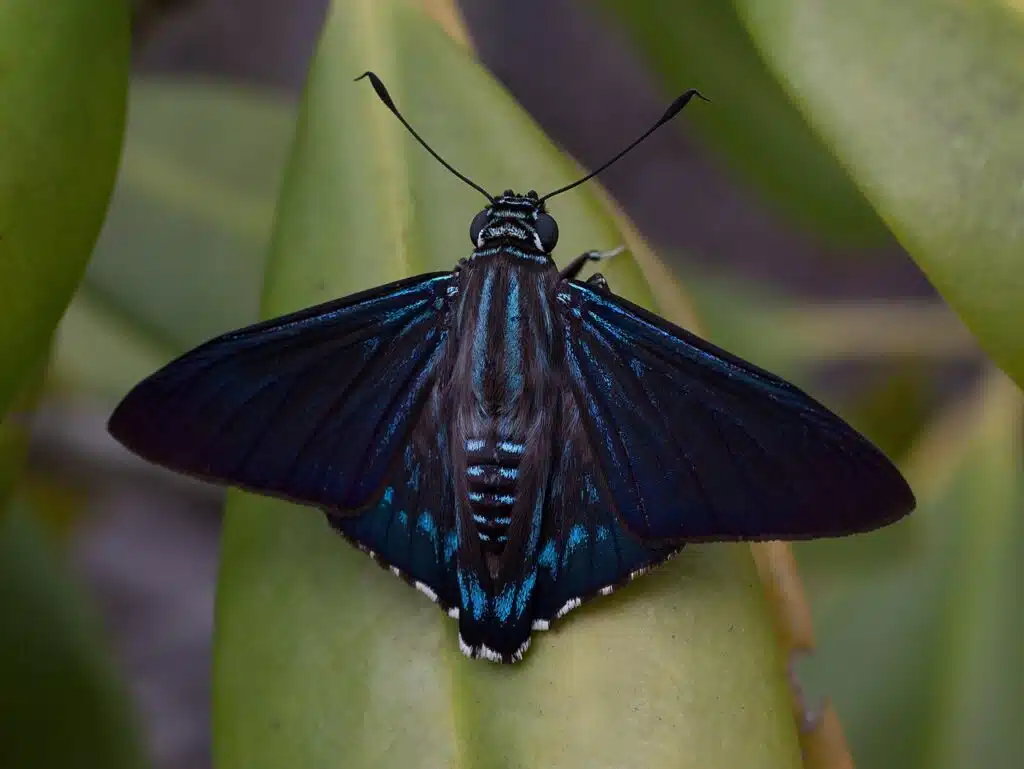
Both Atala and Mangrove Skippers (Phocides pigmalion) are present in Southern Florida.
The difference in coloring is that the Mangrove Skipper is darker.
It has a dark violet-blue color with a black body and black veins.
This species is larger than Atalas as it can have a wingspan of nearly 2.5 inches.
Its habitat spreads to parts of Mexico and even Puerto Rico.
Apart from its preference for subtropical climates, this species is also known for its preference for certain plants for nectar.
Mangrove Skippers most feed on Shepherds’ needles. They also feed on other plants in warm climates such as various wild citruses.
6. Common Checkered-Skipper
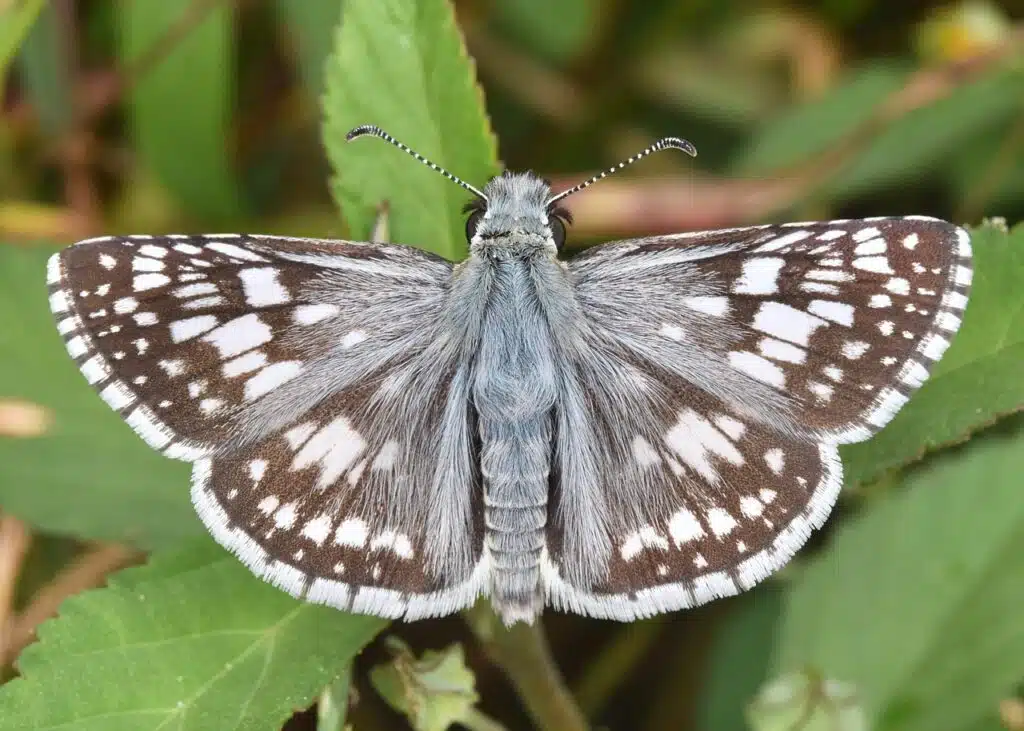
The male Common Checkered-skipper (Burnsius communis) has a blue and black body. This species is common all across the US with particularities in flight season depending on the region.
Southern states are the best place to see the Common Checkered-Skipper due to the long flight season.
Common Checkered-Skippers in the South are active from February to October.
The preferred habitat for the species includes open areas with plenty of sunlight.
These species feed on nectar, similar to other moths in North America. Shepherd’s needle is among its favorite species, together with various types of asters.
7. Long-tailed Skipper
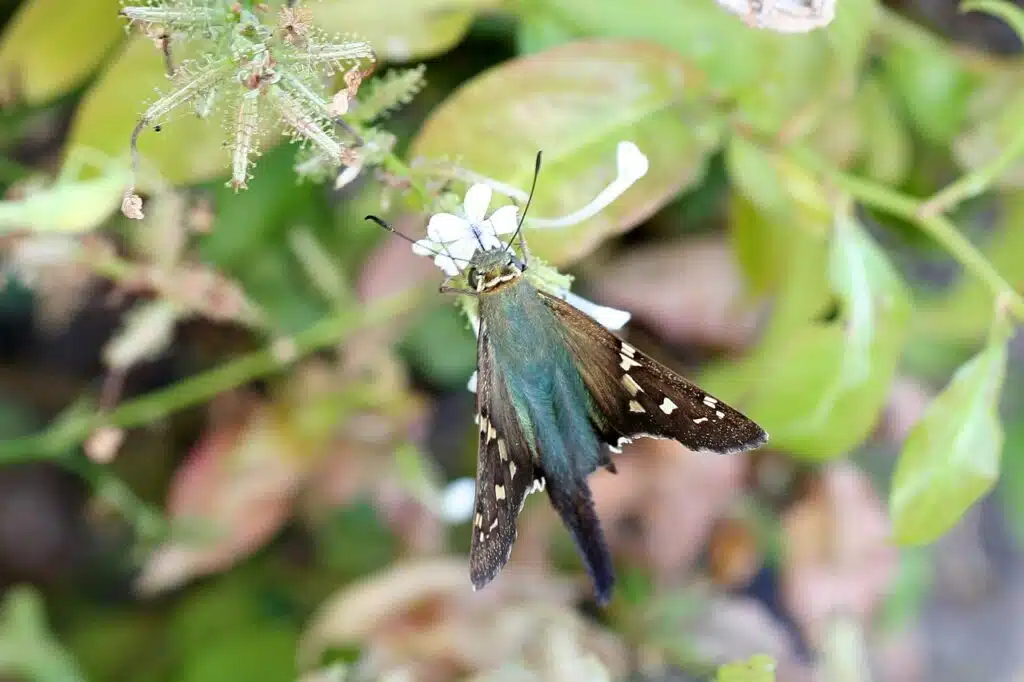
Long-tailed Skippers (Urbanus proteus) are partially blue. A dark metallic blue color is specific to the body of the moth.
This color is seen both in males and females.
The wings have a dark brown and light brown color. White and black patterns are further distinguished on the wings.
Caterpillars of this species are known to be some of the important pests of wisteria species.
These caterpillars have a green body and a black head, without any resemblance to the blue body of the adult moth.
Skippers of this genus feed on nectar as adults. The favorite food of the species is nectar from Shepherd’s needle.
8. Reakirt’s Blue
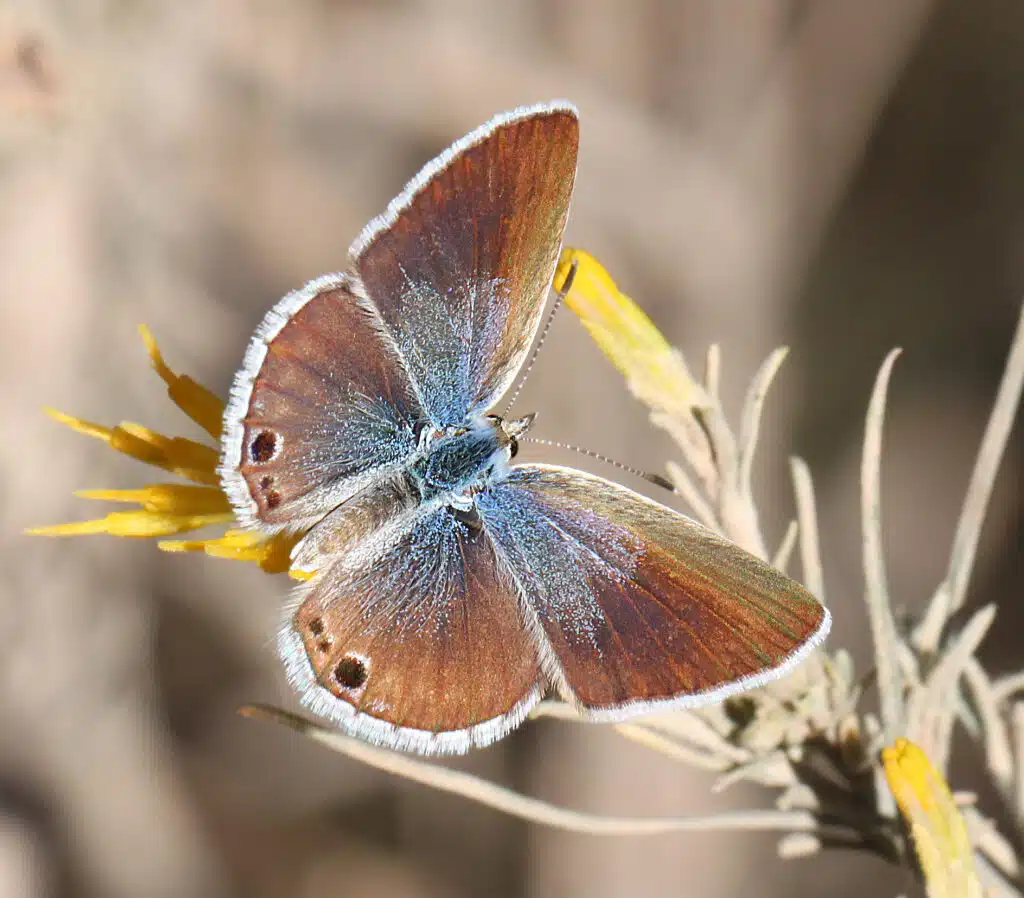
This species (Echinargus isola) is native to Southern America and Florida. It has a light blue body with black spots that feature white margins.
It can be found in all types of habitats in Southern Florida. From open fields to parks and gardens, the species thrives in all warm areas.
Many blue butterflies in North America feed on nectar and fruit.
Reakirt’s Blue has very specific plants they feed on. Plants of the spearmint family such as mint are among their favorites.
This butterfly species also feed on other herbs such as clovers.
9. Silvery Blue
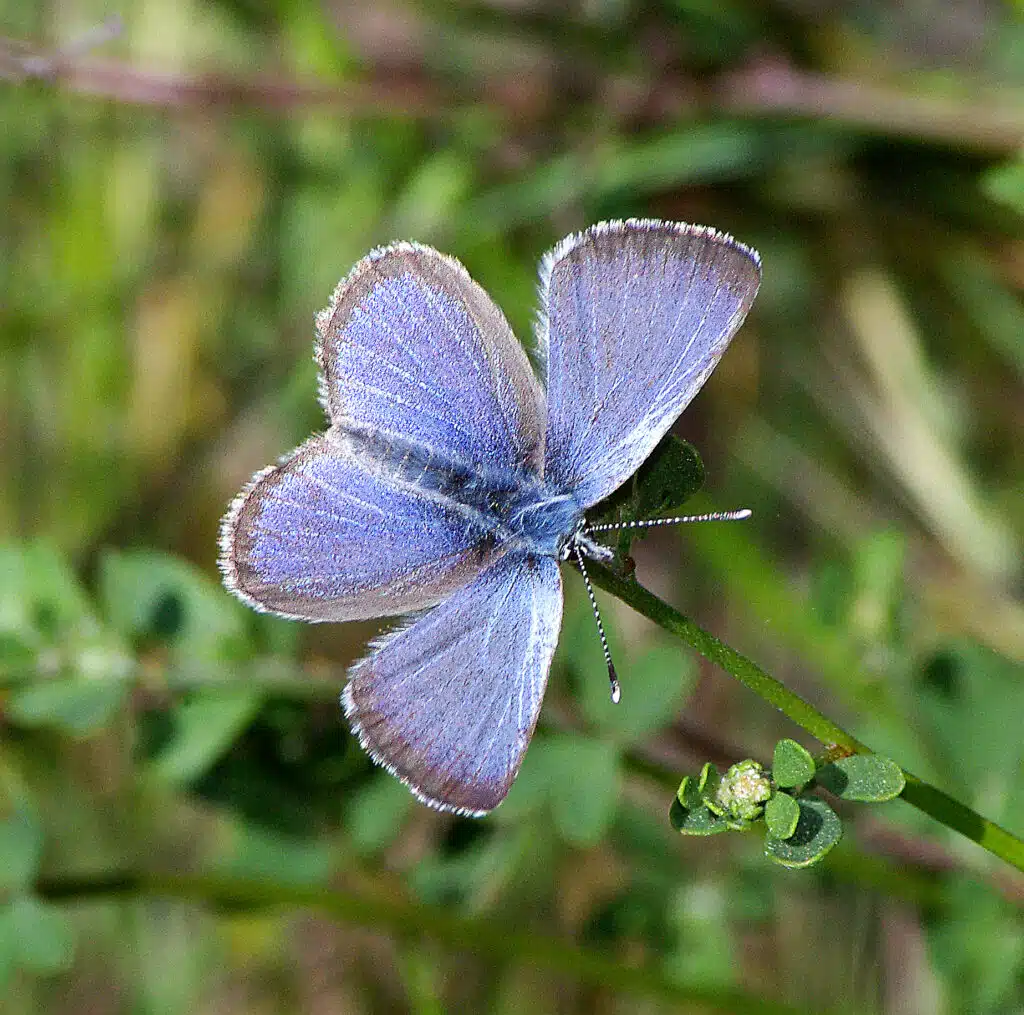
The Silvery Blue species (Glaucopsyche lygdamus) gets its name from the silver nuance of its blue wings.
Both males and females have blue wings with a slight silver tint. It’s the females that have darker blue wings.
Male and females both have white fringes, black spots, and black bordering lines along the wings.
The black spots of the species have distinct white borders which makes them stand out more.
Living in various habitats, these moths are present in all states except Southern US states.
You can find them in open fields at low or high altitudes. Most members of this species are found along asters.
10. Tropical Checkered-Skipper
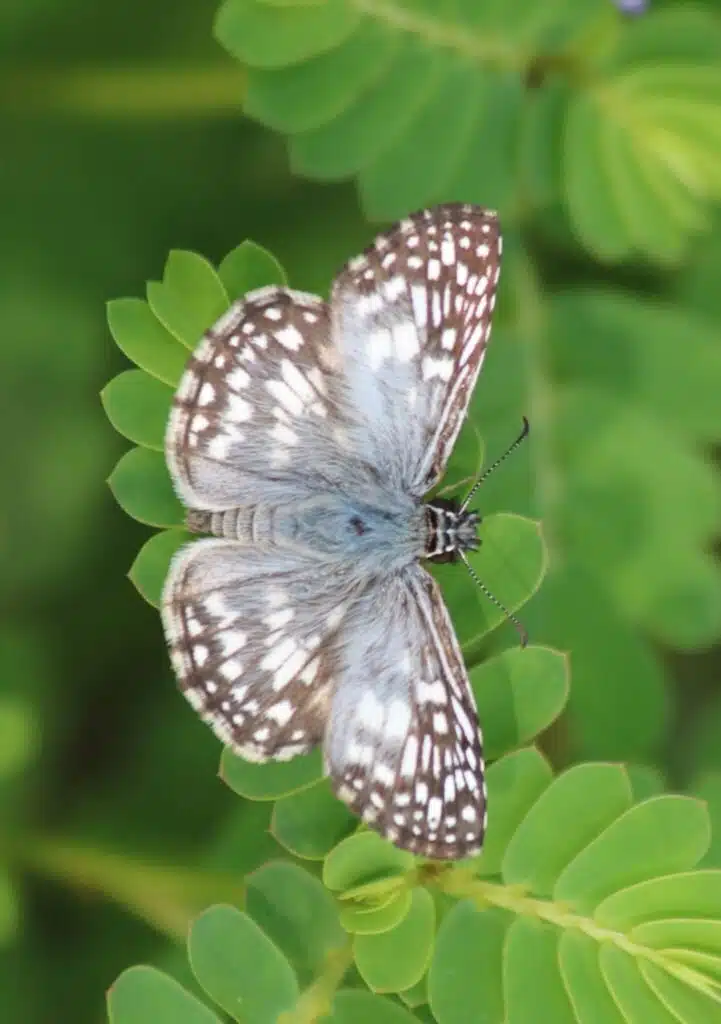
Growing to a wingspan of around 1.5 inches, the Tropical Checkered-Skipper (Burnsius oileus) is one of the main species of blue and black color in Southeastern parts of the US.
This species is recognized for its brown overlays. However, the main color is blue while the margins of its wings are black.
Multiple white dots are also common in the wings of the species.
Finding the Tropical Checkered-Skipper is not easy as this species prefers certain types of flowers for food which means it has a scattered range.
It feeds on the pollen of various sida’s flowers. These are small pink, yellow, or orange flowers that attract many types of insects that feed on pollen.
11. Great Purple Hairstreak
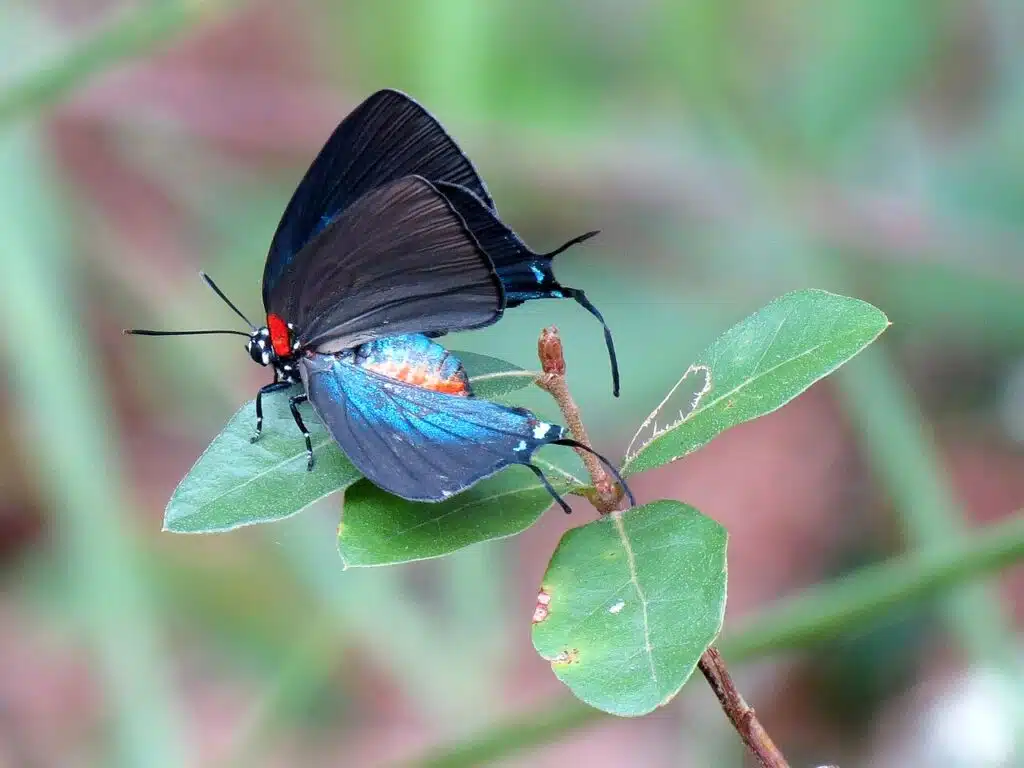
Great Purple Hairstreaks (Atlides halesus) are some of the most common dark blue and black species in the US.
These native North American species have blue and black coloring both in males and females.
Females are darker with wider black areas on the wings while males are lighter with more blue areas on the skin.
The blue coloring of the male is iridescent compared to the blue color of the male which has a greener nuance.
Great Purple Hairstreak seek out parasitic mistletoes to lay eggs on. Caterpillars of the species feed on this plant.
Great Purple Hairstreaks only prefer parasitic mistletoes that grow remotely, favoring smaller plants so that caterpillars have softer leaves to feed on.
12. Boisduval’s Blue
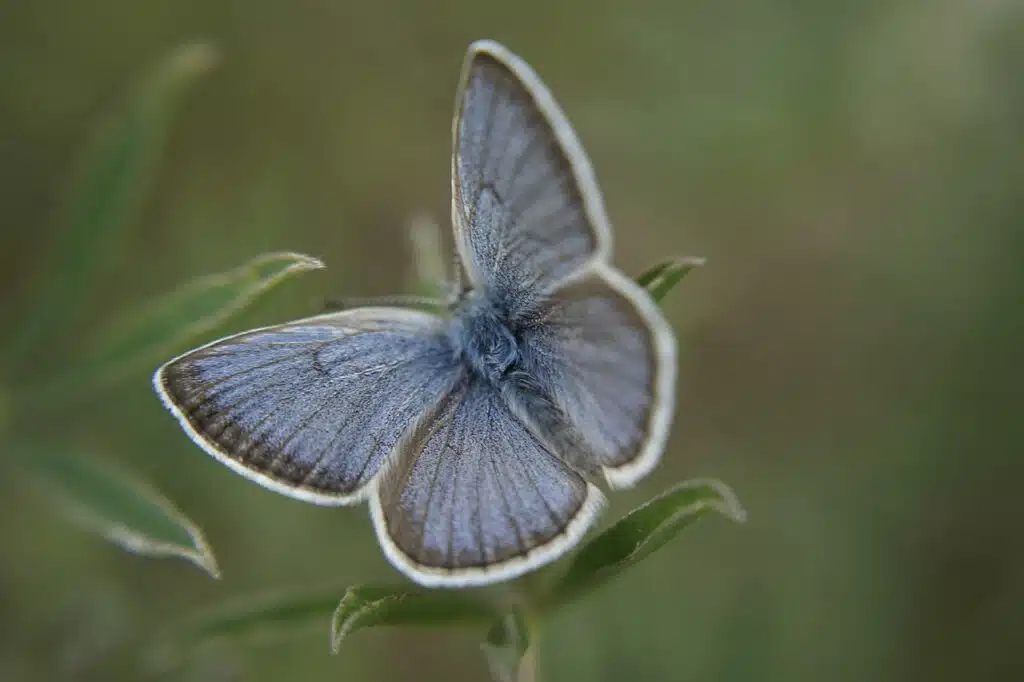
Blue and black are dominant colors in this species. This butterfly (Icaricia icarioides) has a light blue color with black veins and black margins bordered by white margins.
Butterflies of this species are found in all types of habitats of Western US territories.
It lives on meadows, alpine peaks, dunes, and other open areas.
The availability of food is one of the main reasons this species inhabits this area. These butterflies exclusively feed on species of wild buckwheat.
The female lays eggs on flowers of the lupine species. Both adults and the larvae of the species share the same environment as females don’t travel long distances to lay eggs.
Once they pupate, these butterflies become independent moving from lupines to wild buckwheat.
13. Spring Azure

Spring Azures (Celastrina ladon) are a species of butterfly of the Lycaenidae family. This is one of the most versatile blues and black butterflies in North America.
Its range expands to almost all US states including Alaska. It also has a widespread Canadian presence.
The coloring of the species is blue, but there are nuance differences between males and females.
Male Spring Azures have a dark blue body color while females have a violet-blue color.
Male butterflies have blue wings with black veins. The margins are black and white-banded. The body of the butterfly has a dark blue color.
Females have an almost different nuance whereas violet is more dominant over blue.
The combination of violet-blue color may appear lighter in direct sunlight.
Like males, the female also has black and white margins, but wider than those seen on the wings of the male Spring Azure.
14. Mexican Bluewing
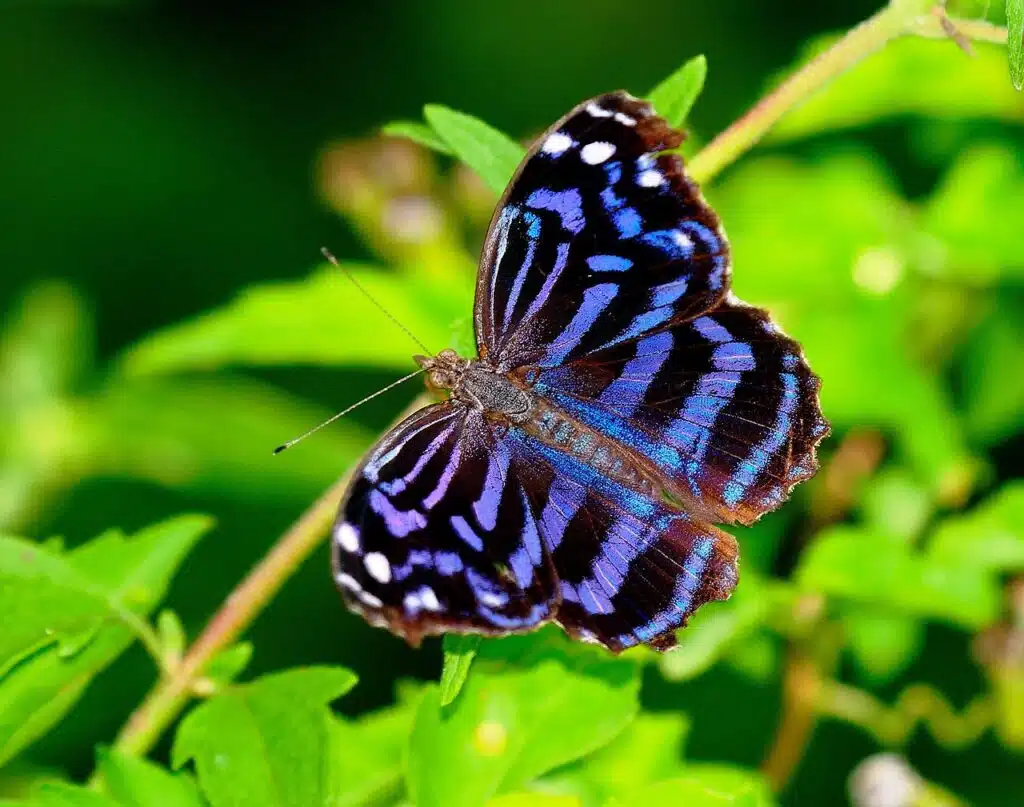
The Mexican Bluewing (Myscelia ethusa) is a common black and blue species native to Central and North America.
Butterflies of this genus are also simply known as Bluewings.
The coloring of the species includes blue, black, and white.
Alternating black and blue stripes are seen on its wings. Small white dots further decorate the wings.
Mexican Bluewings are only blue and black dorsally. Their ventral coloring is brown, black-brown, and black.
This makes the species very good at camouflaging itself as it’s difficult to spot whenever it has its wings closed and when it rests on trees, branches, or leaves on the ground.
15. Sonoran Blue
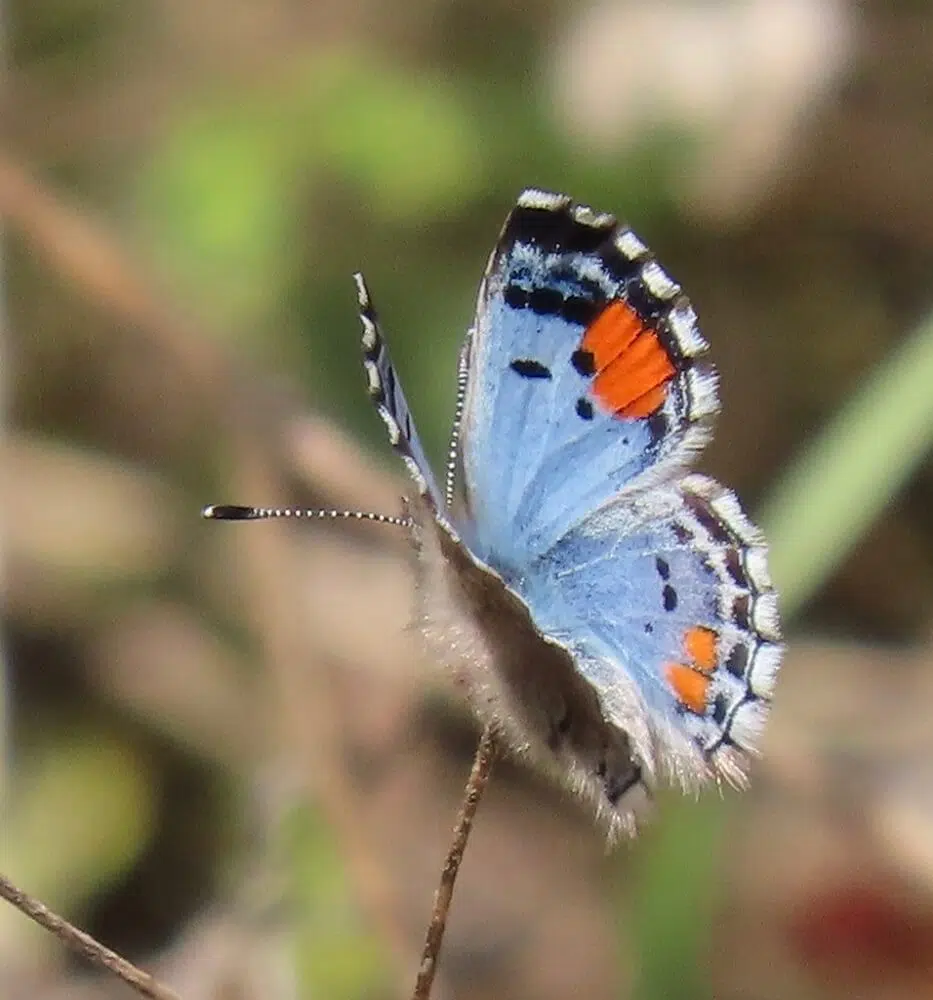
Sonoran Blue butterflies (Philotes sonorensis) are common around The Sonoran Desert. This species is seen in California and Baja California.
Both males and females are dominated by light blue color. The wings have black stripes and black dots. You can find black margins on the wings of this species. Black dots and red dots are also visible on the forewing of the male.
The female also has these dots on the hindwings.
Ventral coloring is mostly brown with black and white dots.
The diet of these butterflies is very different from the diet of other butterflies in North America, given they mostly live in arid climates.
Sonoran Blue caterpillars feed on succuellents.
16. Guava Skipper
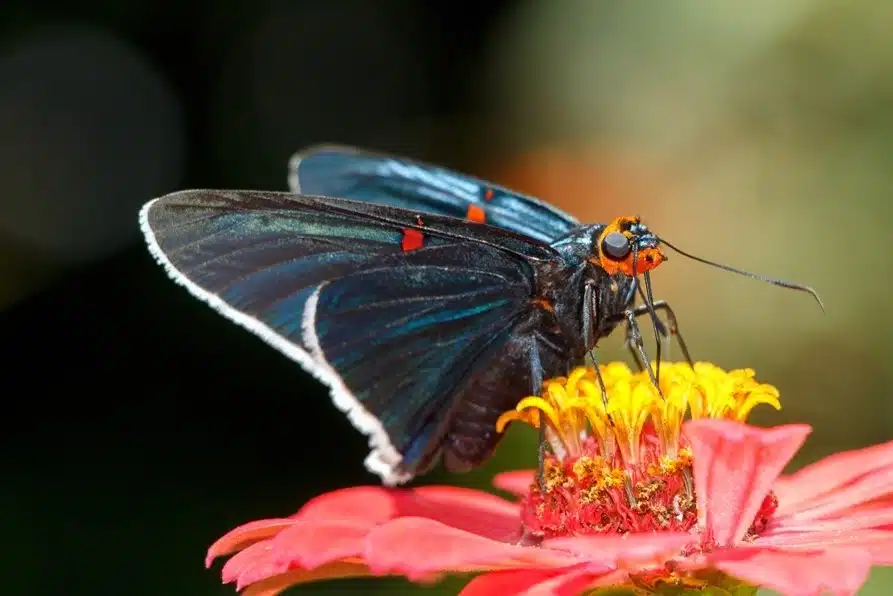
Guava Skippers (Phocides lilea) are some of the largest black and blue butterflies in North America, Central America, and South America.
This is one of the species with a large impact on its host plants due to its size. Guava Skippers grow to a maximum wingspan of 63mm.
Male and female Guava Skippers look slightly different.
The male Guava Skipper has lighter blue coloring on the wings with a black body that features light blue stripes.
Red marks are seen on the wings and the head of the male.
Female Guava Skippers are mostly black or dark blue. Their wings appear darker while the top of the forewings and the body also exhibit light blue stripes, just like the coloring of the male’s body.
The female also has a few red spots.
The exact diet of the species remains elusive given its vast habitat. Guava Skippers are found in an area between Texas and Argentina.
Among most of these territories, the adult Guava Skipper is believed to eat nectar.
17. Blue Metalmark
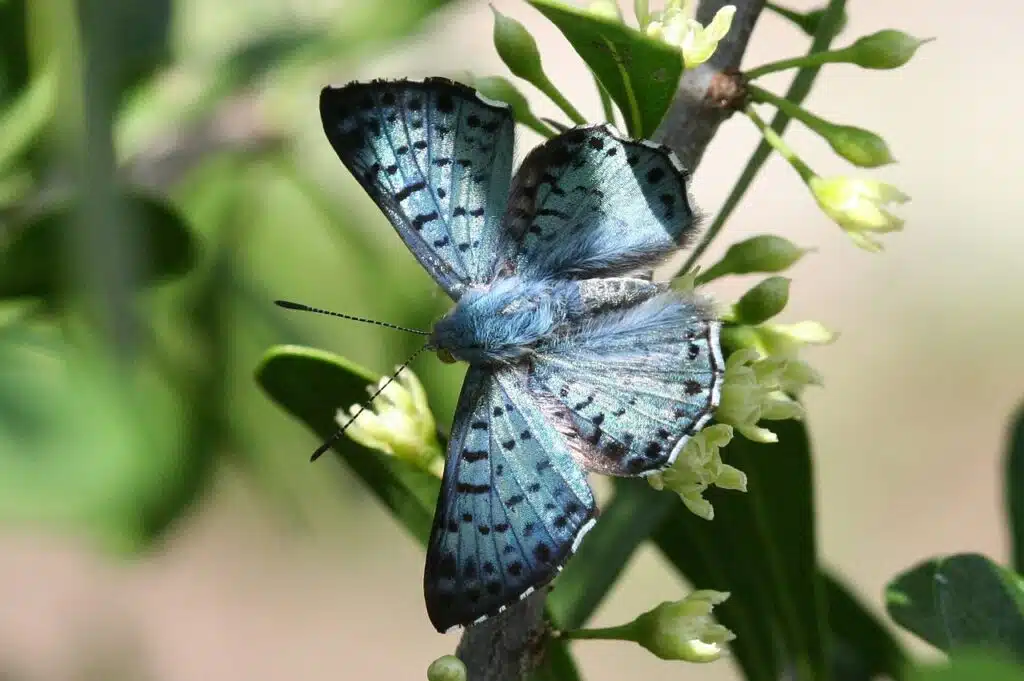
This native species (Lasaia sula) is known for its vivid blue color. Blue Metalmark is named after its metallic blue coloring.
These butterflies have multiple shades of blue on their wings. The outer forewings are deeper blue while the inner parts of the hindwings are light blue.
Black veins are visible all across the wings together with the black color of the outer wings. The antennae of the species are mostly black and white.
Males of the species also exhibit further white margins on the hindwings.
The ventral color of the wings is brown, white, and blue. The ventral side also has black spots, unlike the dorsal which only has black veins.
18. Two-barred Flasher
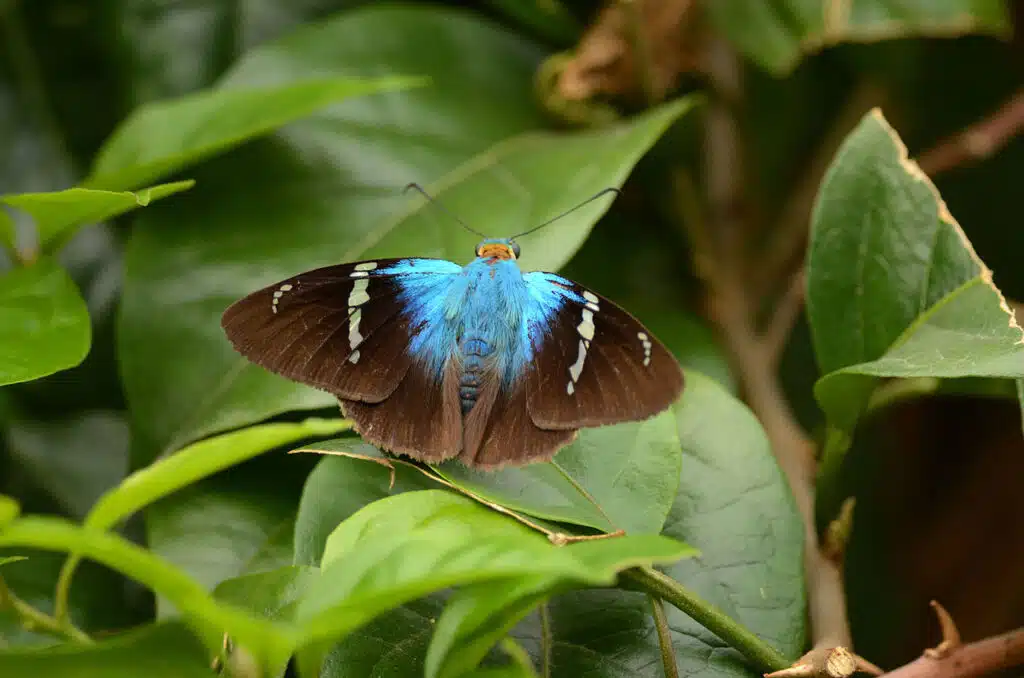
Two-barred Flasher (Astraptes fulgerator) is a type of skipper butterfly named after the apical bands on the wings.
There are 2 long bands on the wings backed by 2 short bands of a white to light blue color. These bands sit on opposite sides of the metallic dark blue body of the species.
The wings are brown and dark brown veins are visible on its wings.
The head of the species is blue while its long antennae are black.
Butterflies of this genus have metallic blue coloring. The blue nuance of the body and the head tends to shine in direct sunlight.
19. Florida Purplewing

Florida Purplewing (Eunica tatila) has deep blue and black coloring.
These butterflies have a wingspan of over 2 inches and are found in the extreme south of Florida and parts of Texas.
The colorful aspect of this species cannot be seen with closed wings as the ventral side is brown to black.
When it comes to the ventral side, blue to purple coloring is dominating the inner wings while the outer wings have thick black banding.
These butterflies live in scattered locations in the US but they aren’t easy to spot given they always sit with their wings closed for camouflage.
The dark brown coloring of the ventral wings together with darker brown veins makes this species resemble dead leaves keeping many predators away.
20. Gilbert’s Flasher
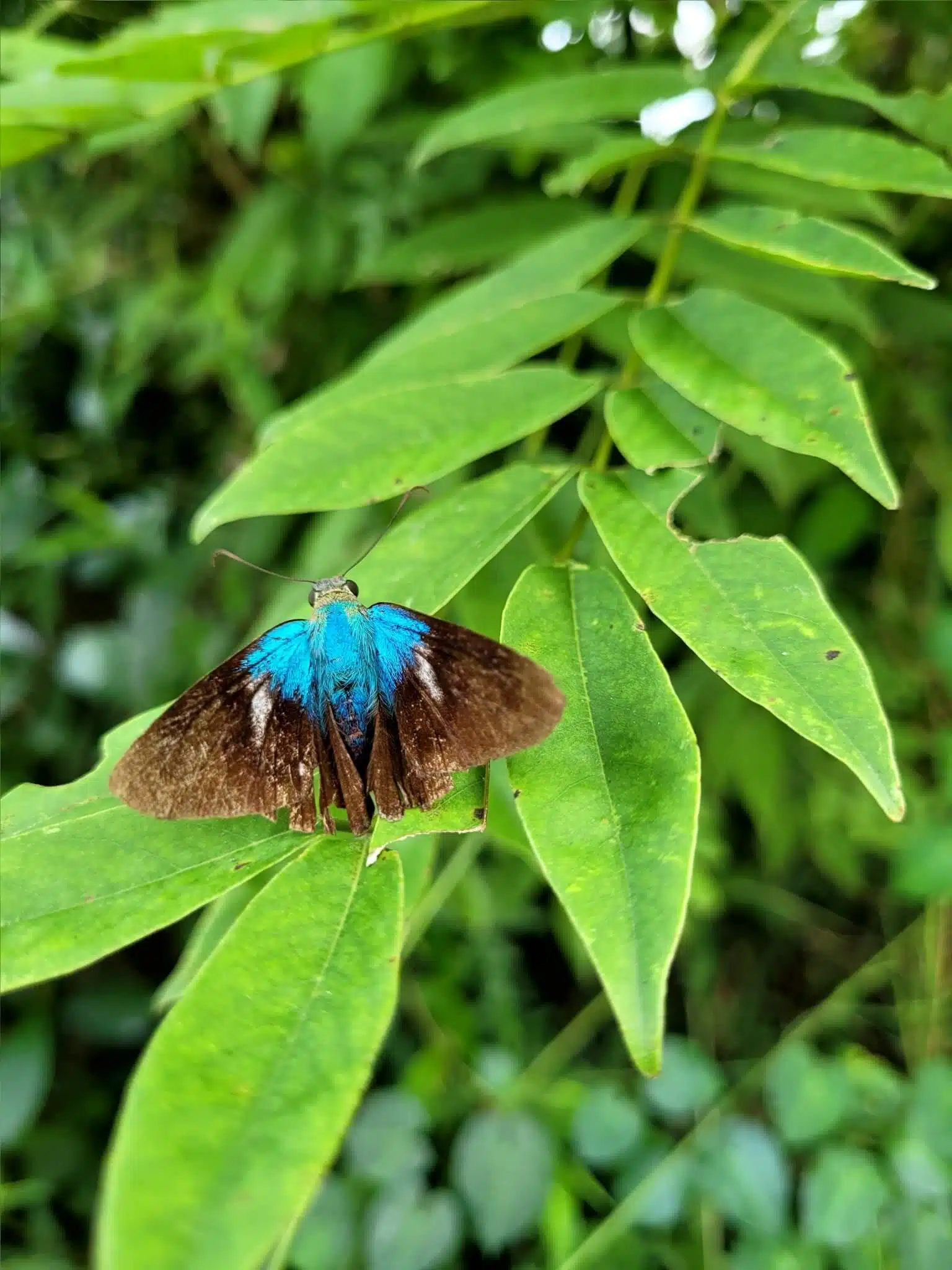
Gillberts’ Flasher (Telegonus alector) is a North American butterfly species.
It has a bi-colored body with brown to black and blue wings.
The upper side of the wings is blue, as is the upper side of its body. The lower side of the wings is brown while the extremities of the wings are black.
The lower side of the abdomen also darkens from brown to black towards the read.
Its head is light blue.
Small differences are seen between males and females. Male Gillbert’s Flasher has 2 white dots or white stripes across the wings.
21. Blackened Bluewing
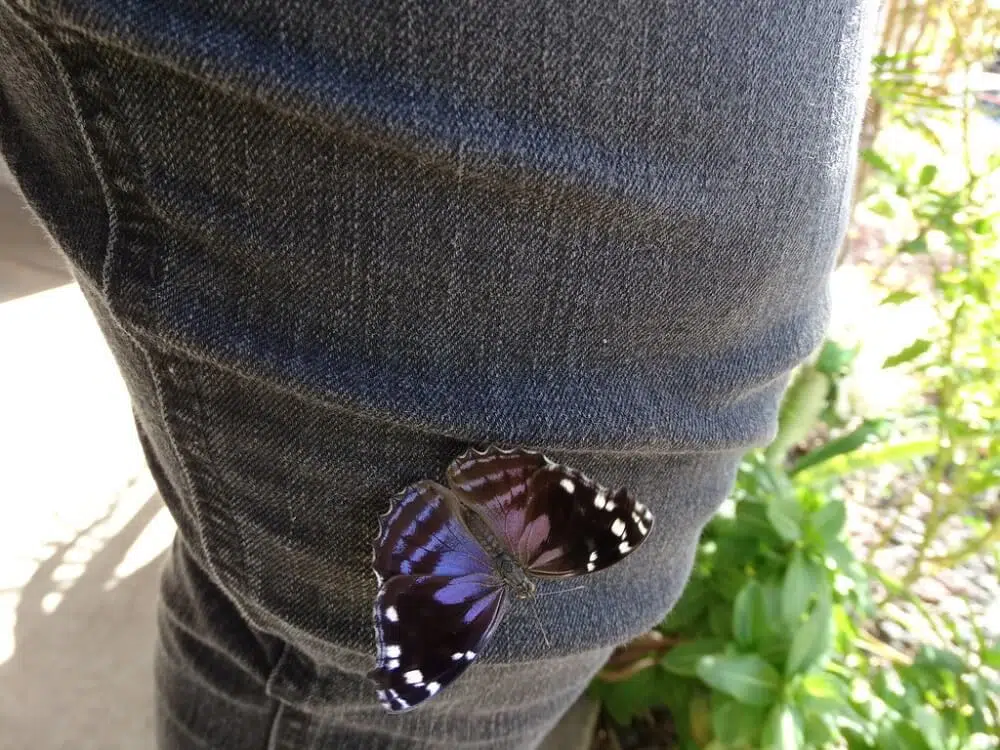
The Blackened Bluewing (Myscelia cyananthe) is a moth with a high presence in Southwestern US territories to Texas.
Blackened Bluewings have no presence in other US states.
It’s also native to Baja California.
As its name implies, this species has black and blue coloring. Black patterns are dominant on its dorsal wings.
Its inner wings are blue with visible black veins. A small section of the wings close to the body has a purple color.
The top of the wings may also exhibit white spots (in the case of males).
22. Forrer’s Leafwing
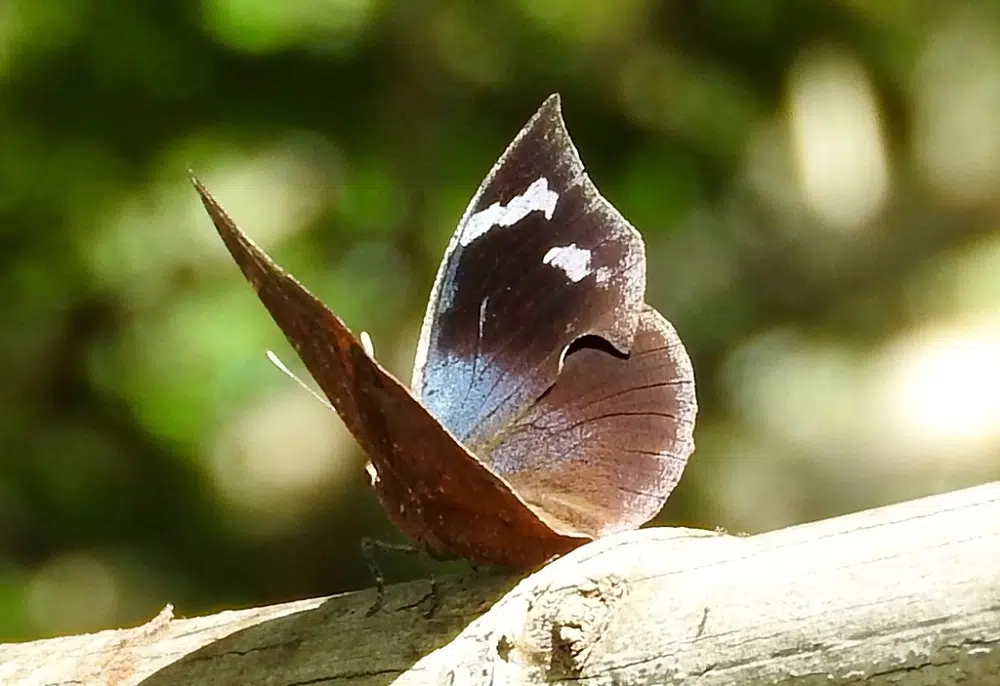
With a wingspan of up to 2 inches, this species (Memphis forreri) only has black and blue nuances dorsal coloring.
The wings have a pattern of blue, dark blue, and black colors. Black coloring is specific to the outer areas of the wings.
The body has a muted blue or a blue-gray color.
The species is also known for having wings that resemble leaves. The ventral color is gray-brown which means its closed wings make the species appear like a leaf.
Mimicry adaptations allow this species to remain undetected whenever it sits on branches. It closes its wings whenever followed by potential predators.
The species is mostly found in woodlands and next to woodlands. It flies at a low altitude just above ground-level leaves.
23. Sara Longwing

Common in Southern US, Sara Longwing (Heliconius sara) is a species that’s native to multiple countries from North to South America.
Sara Longwings grow to a wingspan of over 60mm making it one of the largest black and blue species in the country.
Its aspect is influenced by its rather dark coloring. Black and dark blue are the main colors of its wings.
As with most other species, the darker color (black) is seen on the outer wings while the lighter color (blue) is seen closer to the body.
Yellow bands are visible on the wings both on the male and on the female.
The female exhibits no blue coloring as its wings are brown.
This species feeds on different types of white flowers and yellow flowers. Lantana genus flowers are known to attract adults.
Caterpillars of the species grow on various types of toxic plants for defensive purposes. They are immune to different plant toxins.
24. Blue Admiral
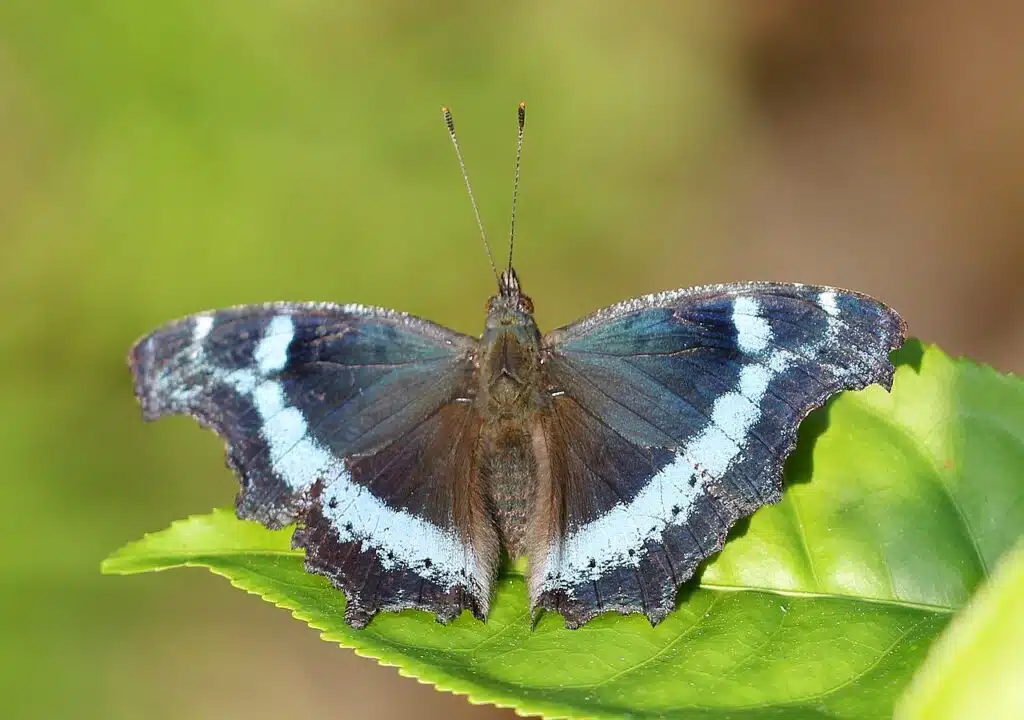
Blue Admirals (Kaniska canace) are one of the most widespread species in the US. It has a mostly black color with long light blue bands on the edges of the wings.
This species is among those that have a wingspan of nearly 3 inches.
Some of the largest Blue Admirals have a wingspan of up to 2.8 inches.
The underside of the species has completely different coloring. Brown and light brown are the 2 main colors of its underside which helps its wings look more like leaves when closed.
Blue Admirals have the size to allow them territorial gains over other species. This is one of the reasons Blue Admirals are highly aggressive and territorial.
They tend to chase away other butterflies from their area.
25. Bell’s Longtail
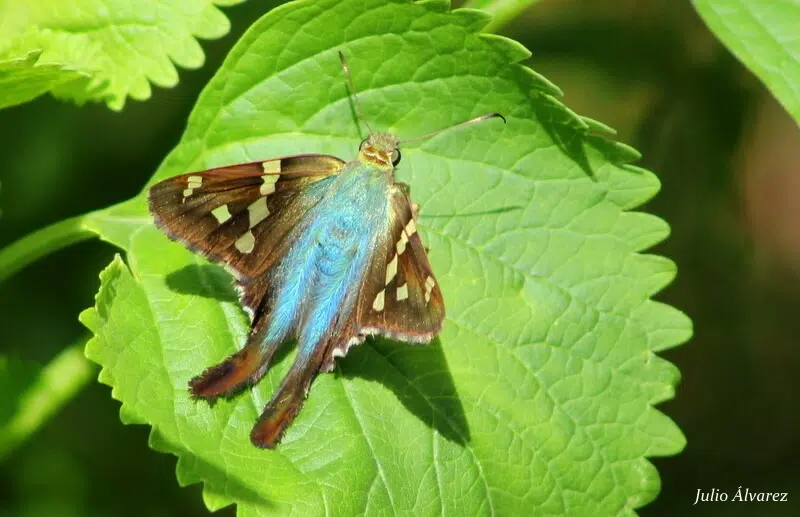
Bell’s Longtail (Urbanus alva) is only found in Southern US territories, Central America, and parts of Northern South America.
This large species has a multicolored body where black and blue are major colors.
Its body and the inner areas of the wings are metallic blues. The species has light brown and dark brown upper forewings and black hindwings.
Light brown or tan spots are further seen on its wings. The species has very long black antennae.
Male Bell’s Longtails have blue to green upper body and head coloring.
Most Bell’s Longtails are found in Bolivia, Peru, and Guatemala.
26. Cascadia Blue
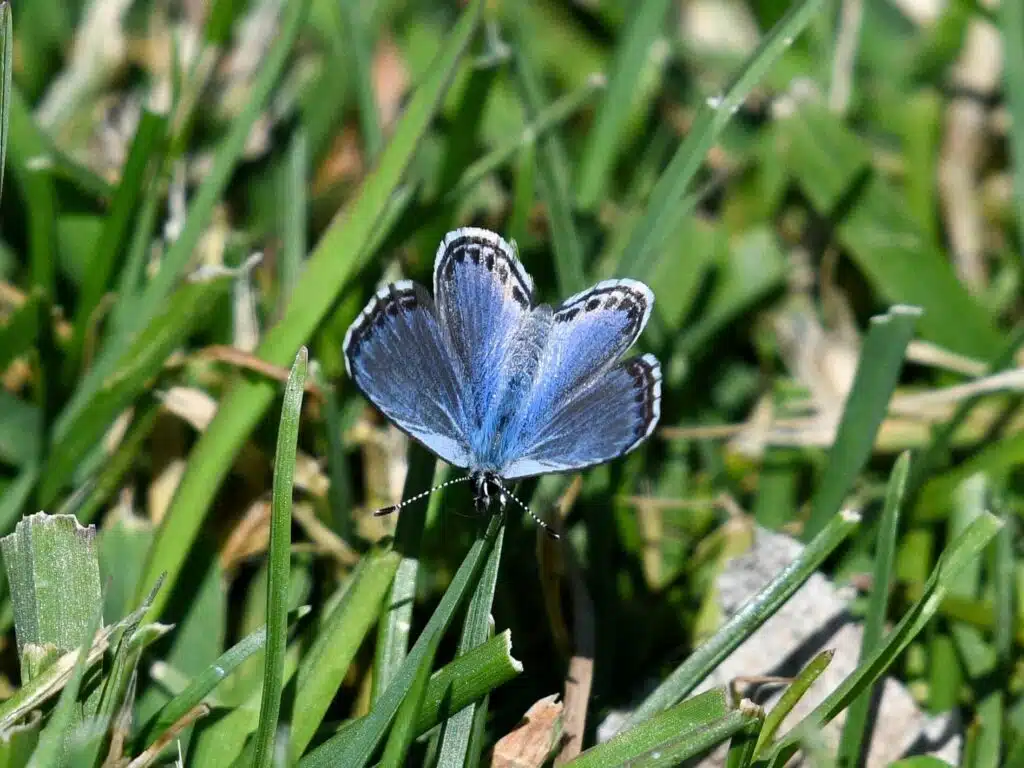
Cascadia Blue (Euphilotes heracleoides) is one of the species with very light blue coloring that’s often interpreted as gray-white.
Its body is also light blue.
The wings of the species have black decorations. Small black dots are visible all across its wings.
Fine black margins are further seen on the wings of the species.
There’s an orange or red band on the outer wings as well.
Cascadia Blue is found in multiple natural habitats in North America. It prefers open areas, ditches, and other short vegetation areas. Cascadia Blues live both in low and high-altitude plateaus.
27. Blue Copper
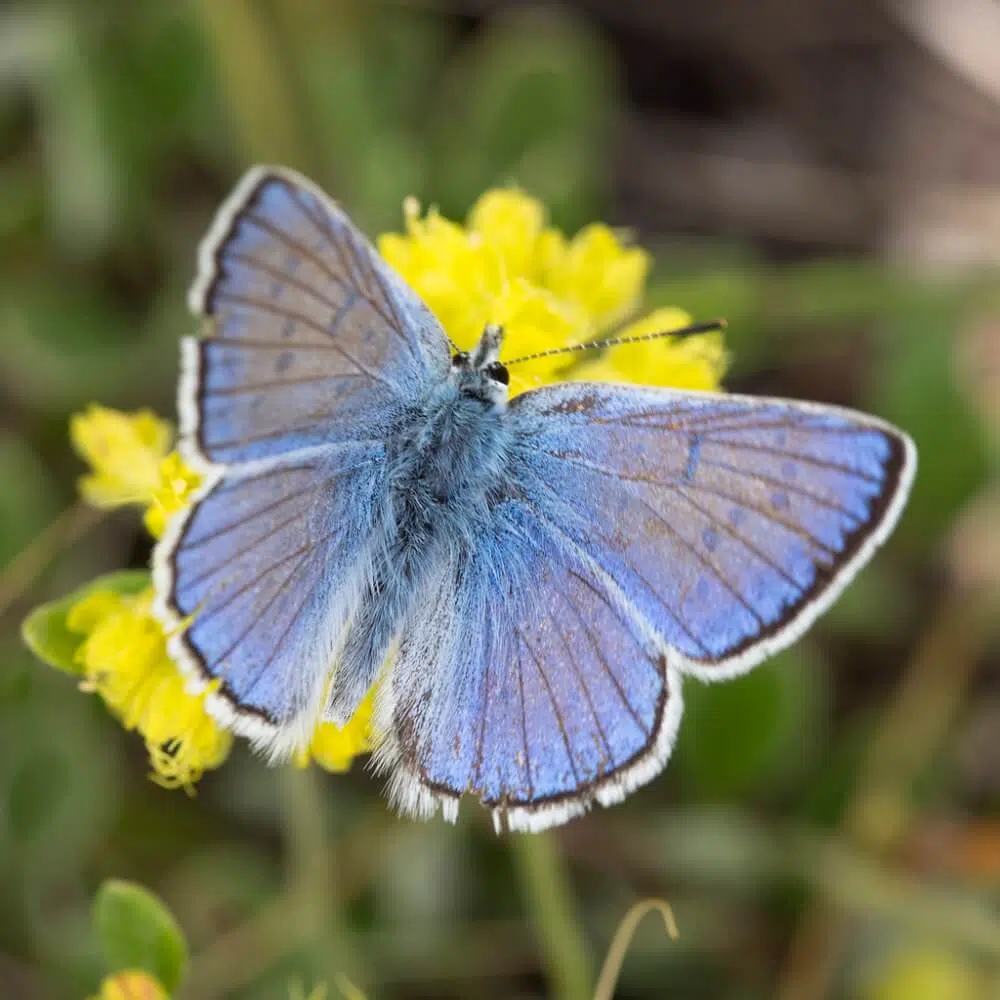
Blue Coppers (Tharsalea heteronea) are dominated by blue and black coloring.
The wingspan of the species is just above 1 inch, at best.
Small coloring differences exist between males and females. The male Blue Copper has dark blue ventral coloring with black veins.
Females of the species have light blue or blue-gray coloring with black dots.
Both males and females exhibit white margins around the wings.
Blue Coppers are among the few blacks and blue species found in Western US states. Its presence is confirmed from California to Canada and around The Rocky Mountains.
28. Anna’s Blue
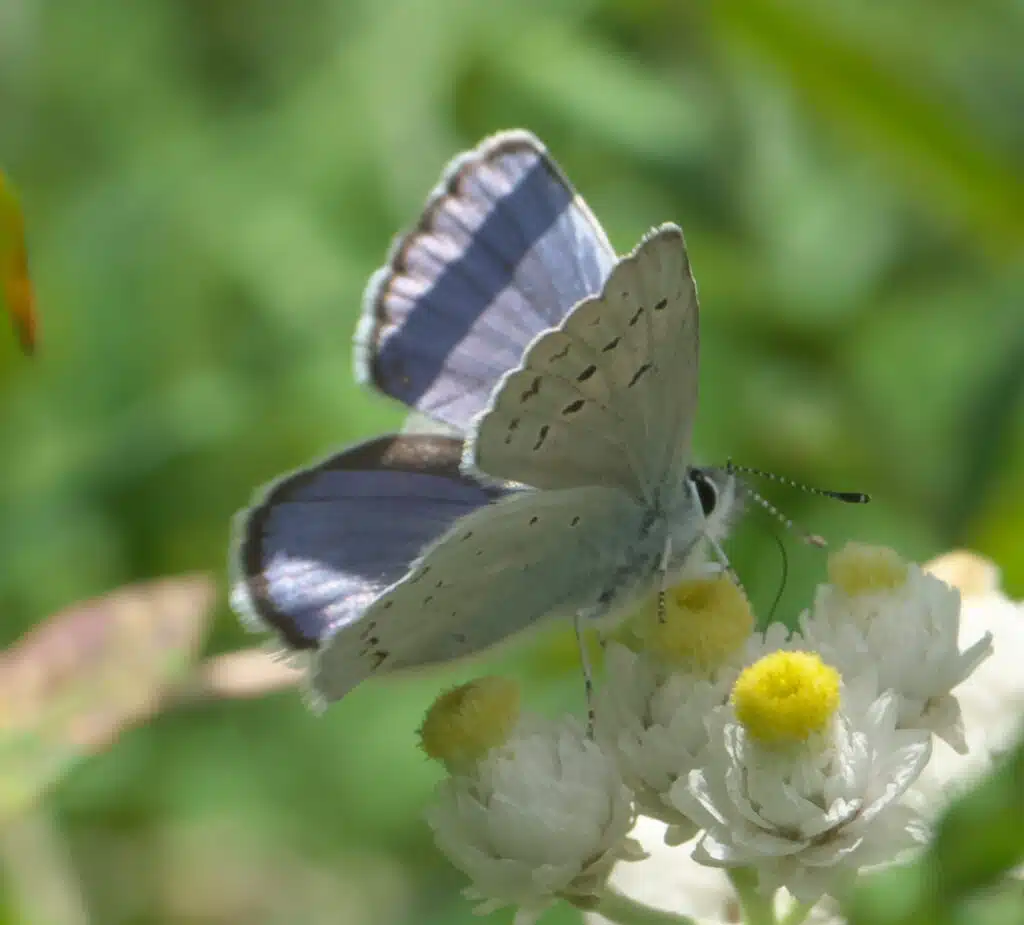
Anna’s Blue (Plebejus anna) is a species highly similar to Blue Coppers in the case of males.
Both species have males with blue dorsal wings with black spots and black margins.
Anna’s Blue females have different coloring. Brown, black, and orange are seen on the female of the species.
As Blue Coppers, Anna’s Blue moths are also seen across Western parts of the US. However, Anna’s Blue has a reduced habitat compared to the habitat of the more common Blue Copper.
29. Arctic Blue
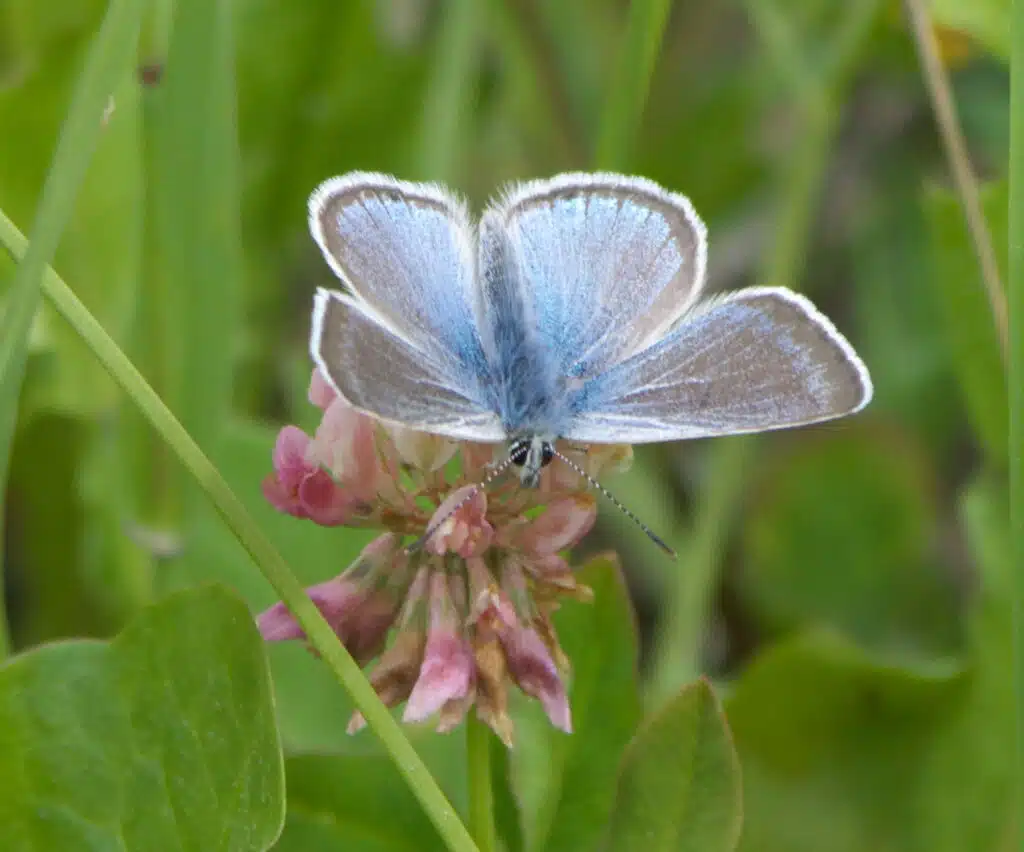
The Arctic Blue (Agriades glandon) is a butterfly of the Lycaenidae family. It’s known for its adaptation to various habitats.
It’s one of the black and blue butterflies also found in Alaska.
This species has dark blue inner wings with a blue body and a blue head. The outer wings are black with white margins.
Black dots are further seen on the wings of the species.
Most differences between males and females are related to the shades of blue.
Males have vivid blue coloring while females have muted blue nuances with black wings. Both males and females exhibit white margins around the wings/.
This species lives in different habitats. It has adapted to living on mountains and meadows but it’s highly present in woodlands.
30. Square-spotted Blue
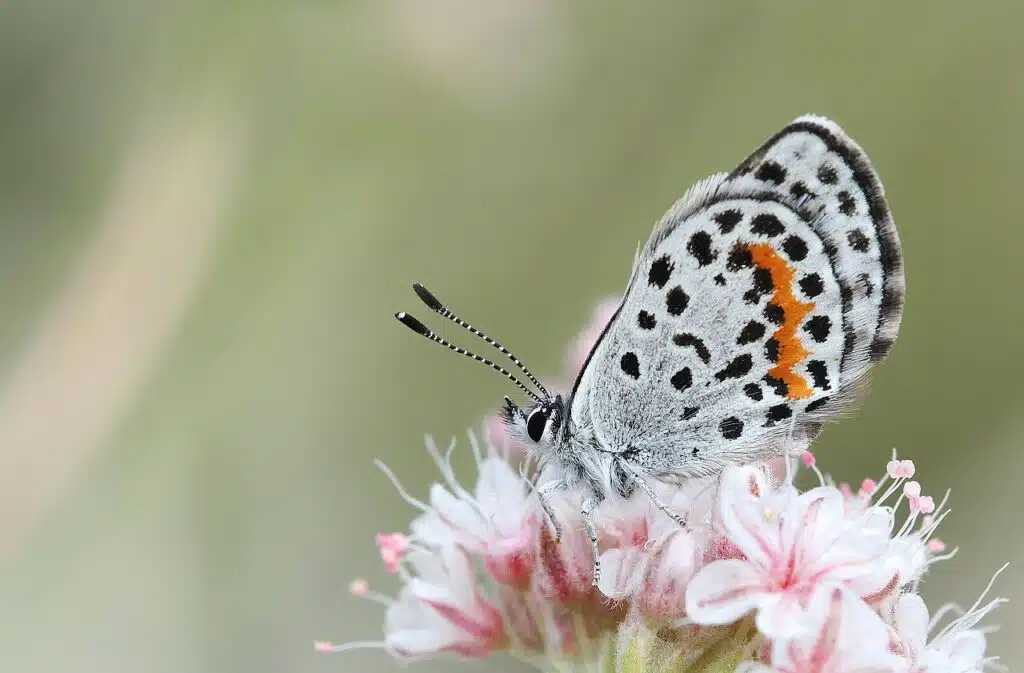
Common in Western and Central North America, the Square-spotted Blue (Euphilotes battoides) is a small species with blue wings.
Male Square-spotted Blues are blue as the females are brown.
The male has light blue wings with black dots and orange stripes.
The body of the species is light blue-gray.
Square-spotted Blues are mostly seen in open areas where they feed on plant nectar. This species prefers wild buckwheat, a common plant among blue and black butterflies.
Further Reading: